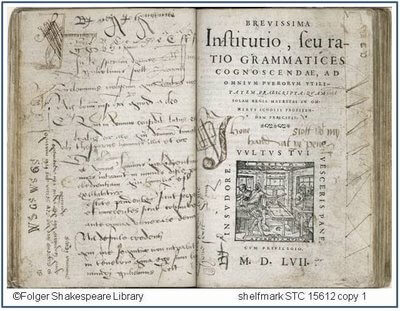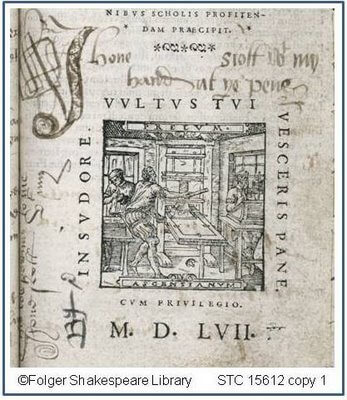Today’s post is in honor of all students returning to school everywhere–and in honor of all their teachers. For me, one of the strongest markers of a new school year is the buying of books (and, as a professor, the endless copying of excerpts of books to be put on reserve). For generations of early modern English school boys, the foundational text of their study was William Lily’s A short introduction of grammar generallie to be vsed. Compiled and set forth, for the bringyng vp of all those that intend to attaine the knovvlege of the Latin tongue. In1542 by Henry VIII made Lily’s Grammar the authorized book for studying Latin, and the work was reissued repeatedly for more than a century, and continued to influence subsequent Latin grammars well after that point. (Lily himself died in 1522, years before all this–what we–and those school boys–refer to as Lily’s Grammar is a text that, in fact, is only partially written by Lily himself.)
Reproduced above is the title page of from a 1557 edition. The most noticeable thing about it, I think, is that nearly all the white space has been written on by its users. I want to point out one particular set of scribblings, those words just above the printer’s device and enlarged below:
Who does this book belong to? John Scott, who carefully notes that point with the phrase “Jhone Scott with my hand at the pene.” John also seems to have started to write this inscription along the gutter, starting at the bottom of the page just to the left of the printer’s device. (There’s something else above that line, but at some point rebinding has made the gutter swallow the words.) At the back endpaper, both “Thomas Scott” and “Gulielmus Scott” have written their names, suggesting that this was a schoolbook that was handed down among the Scott family.
One other quick thing to point out: the printer’s device is, in fact, an illustration of a print shop. If you look closely you’ll see the compositor on the right laying out the type, the man in the middle pulling the press to print a sheet, and the man on the left inking the inkballs. More on printing presses in the future, and I promise a return to Frances Wolfreston once my teaching preparations settle down!


>This is wonderful. I just taught Astrophil & Stella (Gwynn calls it "Astrophil and Spella, whereas I call it "Astrophil, Stella, and the Educational Dominatrix") and wished I had seen this post beforehand.